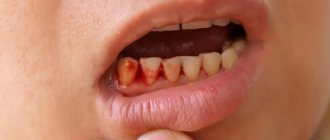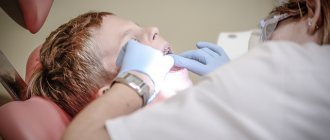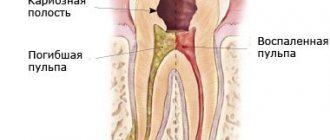What to do if your cheek is swollen after tooth extraction?
Often after a tooth extraction procedure, many people experience swelling that may persist for some time.
Its appearance is natural, since tooth extraction is essentially a surgical operation, after which the wound remaining in the oral cavity remains open. It recovers fairly quickly, but damaged gum tissue will remain swollen for some time. The size of the tumor may depend on several factors, such as the complexity of the removal procedure, the individual characteristics of the person, and the professionalism of the dentist.
What to do after the procedure
- when you arrive home, you just need to lie down and relax;
- you cannot eat or drink for 3 hours;
- for 3 days after surgery, you should not open your mouth too wide, or eat hard or hot foods;
- limit emotional and physical stress;
- hot baths, visiting the sauna, and exercising in the gym are prohibited;
- It is advisable to completely stop smoking and drinking alcohol for a week.
Signs of a tumor that is not dangerous to health
- swelling of the gums and cheeks does not increase and does not have a pronounced form;
- after removing a tooth that caused severe pain, or a wisdom tooth, discomfort and pain should gradually subside;
- even if during the removal procedure you had a slight fever, it should no longer be present, and in no case should it rise;
- there is no unpleasant odor from the hole, which may occur in case of complications.
The cheek tumor can reach its maximum size the day after tooth extraction. Then the swelling should subside.
Avoid physical activity
The patient is prohibited from doing anything that provokes bleeding:
- engage in any sport;
- lift weights;
- do difficult homework;
- to take a bath;
- go to the sauna and solarium;
- travel for a long time in vehicles or fly on airplanes.
Read also: Tooth cyst symptoms consequences
Important! If you do not follow these recommendations, the wound will bleed, heal for a long time, and pus may spread into nearby tissues.
How to remove swelling of the cheeks and gums
If the tumor does not cause particular concern, then it is a natural phenomenon after tooth extraction.
There are ways to relieve pain and reduce swelling, as long as it is not harmful to health.
- It is necessary to apply cooling compresses to the inflamed cheek several times during the day, this can be a bottle of cold water, ice in a cloth, a damp towel, which should be kept for twenty minutes, periodically cooling it in cold water. You will immediately feel relief and notice how the tumor decreases in size.
- People with high blood pressure are more susceptible to post-operative swelling. They are recommended to take sedatives and blood pressure-normalizing medications after tooth extraction.
- Conventional anti-edema products can relieve swelling well - gels, creams, ointments that can be applied to the outside of the cheek.
- To relieve pain, which is inevitable after complex removals, you can take a painkiller (except aspirin) or an anti-inflammatory drug and lie down to rest.
Do antiseptic rinses
An important stage in the treatment of purulent periodontal pathologies is rinsing with antiseptic solutions. Apply:
- chlorhexidine;
- furatsilin;
- "Miramistin";
- "Stomatophyte";
- "Chlorophyllipt";
- solution of soda and salt;
- herbal infusions - chamomile, calendula, sage, oak bark.
The solution should be slightly warm. It is better to make oral baths than to rinse - under the pressure of the liquid you can wash the drainage. Procedures are carried out 3 to 5 times a day.
Contraindicated actions for swelling:
- Under no circumstances should you heat the swollen area, or touch the wound with your hands and tongue;
- rinsing on the first day after tooth extraction is not recommended, as it can wash away the blood clot that protects the socket from infections. In the future, you can rinse your mouth with antiseptic solutions - miramistin, furatsilin, or decoctions of chamomile, sage;
- the first two to three hours after the removal operation, you should refrain from smoking, drinking and eating;
- Until the wound is completely healed, you should not consume solid food, hot and carbonated drinks, or alcohol.
If you follow these simple rules, the swelling will go away quickly enough and there will be no need to visit the dentist.
How gums heal
After surgery, connections between tissues and cells are disrupted. The healing process is the formation of new physiological and anatomical connections between them.
- Formation of a blood clot - forms within 5-10 minutes after surgery and serves as a protective barrier against infection and harmful microbes.
- Formation of granulation tissue - within 3-4 hours the production of granulation tissue (young connective tissue) begins.
- Epithelization and collagen formation lasts up to 7–10 days and is sometimes accompanied by slight itching.
- Regeneration and maturation - the wound “heals” after 2–3 weeks, but complete healing of the fibers requires several months.
When to see a doctor
If you have followed all the rules, carried out all the procedures aimed at reducing swelling, and your condition continues to worsen, then this is a sure sign that you need to urgently consult a dentist. Immediate medical attention is required if:
- the next day the swelling increased, and the pain did not decrease;
- the temperature has risen, general health has worsened;
- opening the mouth is accompanied by painful sensations, and the smell of rotting from the hole is felt.
All these symptoms should prompt an immediate visit to the dentist to avoid serious consequences.
Swelling does not go away after gum incision and drainage installation
My cheek was swollen, I went to the doctor, the filling was removed, the canals were cleaned, a little pus came out, and I was sent home.
The next morning the swelling was greater, the temperature did not drop. I went to the surgeon, he said that an incision still needed to be made, he made and installed a drainage, but after that 4 hours have passed, the swelling is not getting smaller and the temperature persists. What should I do since tomorrow is Sunday and the doctor is not working? (The cyst will be removed soon)
The swelling will not go away immediately; it usually goes away on the third day. What do you mean about removing the cyst? Treatment with endodontics or surgery can begin after the complication has resolved.
Contact phone number
Comments and reviews 15
Four days ago, gumboil came out and the gums were cut. A drain was placed at the incision site. Today is the fourth day the swelling is not going away, and in the place where the drainage is located, the wounds are twitching. This is fine? Is this how it should be? Answer
No, due to drainage there should have been an outflow of exudate from the apex. If swelling persists, you should immediately contact a dental surgeon. Answer
General dentist
The tooth below, which had already been opened earlier, hurt. The next morning my cheek and chin were swollen. We took a picture. The doctor said that there is a slight darkening - a cyst. They cut the gum, installed drainage, and am taking antibiotics. The swelling has subsided a little, but pain at the bottom of the chin sometimes appears. Sometimes it hurts to move your jaw. Is this how it should be or is it discomfort due to drainage? Answer
An examination and x-ray are required. Most likely, a complication such as periostitis has arisen. Discomfort and soreness may persist until the inflammation subsides, but this is not due to drainage. The causative tooth should be treated endodontically. If, after completing a course of antibiotics, pain and discomfort remain, then it is better to contact a dental surgeon again. This is normal for now. Answer
General dentist
Yesterday they made an incision, installed a drainage, and the swelling became stronger. Antibiotics are not allowed, because I am on breastfeeding. Why doesn't the tumor go away? What to do? Answer
The swelling takes a long time to go away, but without taking antibiotics complications may develop. To prevent them, you should see your doctor and follow all these recommendations. Answer
General dentist
3 days ago, a tooth was removed, the gum was cut, and drainage was installed. Yesterday (two days later) the drainage was removed, but the swelling had not yet subsided. This is fine? Doesn't bleed, there was no temperature during drainage. Answer
The tooth began to bother me and I immediately went to treat it, it turned out that pus had accumulated under the roots, the doctor tried to clean the canals for me, but out of 3 she only cleaned 2 and prescribed medicine for 3 months. In the end, it only lasted me for 2 weeks, the tooth began to pull, and in the morning my cheek was swollen with dysplasia. The doctor referred me to a surgeon, who cut the gum and inserted a drain, but the swelling became even larger and the pain intensified. Is there a chance that the pain will decrease, the pus will come out and the swelling will subside? Answer
If you follow all the recommendations, the swelling, and with it the pain, should go away. Answer
General dentist
Today the flux appeared. I went to the dentist, but they didn’t let me remove the tooth; the prosthesis was holding on to it. They made an incision and installed a drainage. By evening the swelling became larger and half of the rubber band fell out. I take antibiotics and rinse my mouth. Temperature 37.5. What to do? When will the swelling go down? Answer
After taking medications and relieving the acute symptoms of purulent inflammation, a targeted X-ray of the causative tooth should be taken and endodontic treatment of the tooth should be performed (treatment and filling of the root canals with the elimination of the inflammatory focus of infection behind the apex of the tooth root). Consult in person with a dental therapist. Answer
After an incision in the gum with pus, the cheek became swollen
The question is this: the day before yesterday my cheek started to swell, yesterday I went to the local clinic, took a picture, and said it was a cold and a small accumulation of pus. They made an incision and put the elastic on until Sunday. This morning I woke up, my cheek was swollen more than 2 times.
With what it can be connected? Is this normal? (Prescribed antibiotics and rinsing).
Change your doctor and go to educated and experienced doctors. The appearance of pus on the tops of the tooth indicates a chronic process (periodontitis). An incision, drainage and antibiotics affect only the effect, but not the cause, and can only temporarily relieve the exacerbation.
Read also: Cyst on a child’s gum
Contact phone number
When a swelling may be a sign of complications
Implantation is a popular safe method of restoring lost teeth. However, like any surgical intervention, it is inextricably linked with the risk of complications.
Complications accompanying swelling after implantation can be early and late. The early ones include :
- sharp pain in the gums;
- numbness of the tongue, cheeks;
- bruises, hematomas;
- inflammation of soft tissues;
- divergence of seams.
These are standard signs that appear even with correctly performed implantation. They usually go away on their own or can be easily fixed by a specialist. More complex cases may indicate both a mistake by the dentist and failure to follow the recommendations by the patient.
You should immediately consult a doctor if:
- increasing swelling on the face;
- lack of positive dynamics;
- hardening of the swelling;
- the appearance of additional symptoms (blue discoloration, hyperemia, hematoma);
- redness of mucous membranes;
- increased body temperature (above 37.2°C);
- prolonged pain;
- bleeding or purulent discharge from the wound.
These signs indicate a possible infection of the tissue in the area of the implanted tooth and the onset of an inflammatory process. Sometimes they appear due to a tendency to allergic reactions or against the background of autoimmune diseases in the patient. In the event of such a development of events, there is no point in delaying visiting the clinic.
Late complications may appear a month or even a year later. These include:
- inflammation of the maxillary sinuses when installing an implant in the upper jaw;
- hyperplasia of the mucous membranes around the rod;
- damage or rejection of the structure at the stage of osseointegration;
- peri-implantitis (occurs due to insufficient oral hygiene).
Treatment is aimed at stopping foci of infection and includes: rinsing with antiseptics and taking antibiotics. In advanced cases, removal of the implant will be required.
What is gum drainage and what is it used for?
Often in dental practice, doctors install drainage in the gums. We will describe what it looks like, for example, after tooth extraction, photos and what to do if it falls out. After all, the medical procedures performed in the office are not always explained to the patient, so they are afraid and do not understand the full importance of the procedure.
In fact, drainage has been used in surgery for quite some time. And if previously these were tubes made of dense materials, today they look quite aesthetically pleasing and do not interfere with the patient. But their role in the treatment process is so great that it cannot be underestimated.
What is gum drainage and why is it needed?
Such a device was first invented by the French surgeon Chassagnac. Using simple tubes made of glass or rubber, doctors could remove excess fluid from the patient's tissues or cavities. To do this, they were inserted into open wounds and left for several days.
Today, not much has changed, but the tubes themselves have become smaller, thinner, softer, and sometimes even resemble a small strip. Nevertheless, their main function has been preserved:
- when the gum is cut and drainage is installed, it does not allow the wound to heal;
- promotes the removal of pus, blood, ichor from the affected areas;
- helps inject the medicine directly into the infected tissue.
The drainage is removed only when the swelling subsides, which indicates complete cleansing. Now you can start healing the wound, for which various medications are prescribed, for example, in the form of gels, which can speed up this process.
Nowadays, the most popular and successful substances used to create drainages in dentistry are rubber and latex. Such a waterproof material is easily retained in the wound, preventing tissue from being drawn in, and a small piece that remains outside performs the function of removing pus from the tumor, but does not interfere with the patient.
Indications and contraindications
Why and in what cases is the gum opened to install drainage?
- the appearance of flux, that is, when the patient’s cheek is swollen, which indicates a pathological process called periostitis;
- in order to accelerate tissue healing after severe cases of tooth extraction;
- with alveolitis;
- when it is necessary to periodically inject medications into the wound, which is also done using drainage;
- if pathogenic formations are detected in the root zone of the tooth, for example, cysts or abscesses.
In rare cases, this procedure will not work:
- if the patient has problems with blood clotting, then doctors try to avoid any incisions if possible;
- If you have an allergic reaction to the anesthetics administered, complications may also arise.
But in any case, the procedure for removing purulent or bloody discharge must be carried out, since without this it is almost impossible to cure most diseases. One way or another, the doctor must find a way to do this in order to prevent sepsis.
How is gum drainage performed?
This procedure is performed only by specialists in a dental office. Most often the installation process looks like this:
- Examine the oral cavity and determine the location of the lesion.
- An x-ray is taken to better diagnose and clarify the location and depth of purulent formations.
- Local anesthesia is administered, having previously specified whether the patient is allergic to the medications used.
- The gum is cut in the area where the tumor appears with a medical scalpel.
- The open cavity is mechanically cleaned and treated, and an antibiotic or antiseptic is injected there to speed up the healing process.
- A latex strip is fixed for constant fluid outflow.
Read also: Tooth hurts and cheek is swollen, what to do
The difference in individual manipulations depends on the preliminary treatment process. For example, if a tooth has been extracted, then there is no need to further dissect the tissue, but simply insert a drainage into the open hole.
A latex strip is inserted into the incised gum for a period of 3-5 days, but much depends on the rate of fluid outflow. This device should remain in the wound until the swelling subsides and the source of infection is completely cleared. In cases where at the end of this period the swelling does not decrease, you should consult a doctor for a new consultation.
How to remove the drainage yourself?
For many patients, even a small latex strip interferes with eating, talking and creates a lot of inconvenience. It is not surprising that they want to get the drain out as soon as possible. Is it worth doing it yourself or is it better to have the procedure done in a doctor's office?
During its installation, the dentist usually warns that this strip may fall out on its own or can be removed at home. But it will be safer to go to the clinic for help from a specialist who will do it correctly.
If you decide to remove the drainage yourself, you will need:
- Wash your hands thoroughly and disinfect them.
- You can rinse your mouth with some antiseptic solution to disinfect the surfaces around the wound.
- Stand in front of a mirror, grab the edge of the strip with your fingers and slightly pull it outward.
Many people are concerned about the question of whether it hurts to remove drainage from the gums. This procedure is simple, but can cause pain and bleeding. Doctors recommend additional rinsing of the treated area for several days after this in order to disinfect the surface and speed up tissue healing.
A doctor is consulted if bleeding does not stop after removing the latex strip for two hours. This may indicate that you have hit a large vessel or that some complication has arisen.
What to do if it falls out?
It is important to understand the drainage process itself in order to respond to any changes in a timely manner.
For example, if a strip falls out in the first days of treatment, when the swelling has not yet subsided, you should consult a doctor to have a new one installed. Its loss could be due to improper fixation.
But it is strictly forbidden to return the device to the hole yourself. This can cause re-infection and various complications.
If the drainage occurs on the fourth or fifth day or even earlier, but the swelling has subsided and there is no pus in the wound, then you don’t have to worry about it. It is enough to observe the condition of the affected area. When, after the drainage falls out, the tumor does not reappear, it means that it has already been completely cleared of pus and the latex strip has managed to fulfill its main purpose.
: a procedure for removing pus from the gums.
How much do they put the structure on?
Drainage is installed for approximately 4-5 days. In most cases, this time is enough to completely remove excess fluid from the pathogenic formation. Doctors limit the time to remove the drainage to this period.
In some cases, the strip falls out earlier, but this does not lead to complications, since all the pus has managed to come out and no longer contributes to re-infection. If, even a week after installing the drainage or a few days after its removal, the swelling does not subside, then additional diagnostics and other medical procedures are needed.
Recommendations in the postoperative period
It is very important to follow the recommendations of a specialist - the condition in the first few days after surgery, the speed of tissue healing and minimizing the consequences depend on how carefully the advice is followed.
- At the end of the operation, it is necessary to apply cold to the site of future localization of edema. The clinic staff will take care of this.
- To speed up the tissue healing process, a special dental paste, solcoseryl, is applied to the wound site. The ointment must be used in the future as prescribed by a doctor.
- Try to stay in an upright position for as long as possible - stand, sit. When sleeping, keep your head up and sleep on a high pillow. These measures will increase the natural flow of blood from the head, thereby reducing swelling.
- To speed up wound healing, it is necessary to rinse your mouth with a special antiseptic solution prescribed by your doctor every time after eating.
- The diet should be changed in favor of soft and liquid foods. Avoid eating solid, rough foods for a while: meat, nuts, unripe fruits.
- Follow the rules of oral hygiene. It is important to brush the rest of your teeth as usual - avoid allowing plaque to build up.
What to do to relieve cheek swelling and reduce discomfort
Medicines
To alleviate the general condition, relieve pain, immediately after surgery the implantologist prescribes medications:
- painkillers - “Nurofen”, “Ketanov”, “Dexalgin”;
- antibiotics - “Amoxiclav”, “Augmentin”, “Flemoklav”;
- antiseptics - “Chlorhexidine”, “Tantum Verde”, “Miramistin”, “Betadine”;
- non-steroidal anti-inflammatory drugs - Nimesil, Ibuprofen and others.
The drugs disinfect mucous membranes, prevent the development of harmful microorganisms, and relieve tissue swelling. Depending on the clinical picture, probiotics, calcium, vitamins and immune boosters may be additionally prescribed.
Regardless of the complexity or duration of the operation, the patient must strictly follow all the dentist’s instructions and treat the oral cavity with recommended products. Self-medication is dangerous due to the development of complications.
Folk recipes
The following will help reduce swelling and speed up wound healing:
- decoctions of chamomile, sage or calendula;
- infusion of oak bark.
Plants have anti-inflammatory, bactericidal, regenerating effects. You can start rinsing only 2-3 days after installation of the implant. It is equally useful to rinse your mouth with warm water with the addition of soda. Proportions: dilute 1 dessert spoon of soda in 200 grams of water.
- Complete restoration of the dentition in just 4 days!
more detailsRoott Pterygoid Implants Sinus lift is no longer needed!
more details
Once and for life! Express implantation in 4 days with a permanent ReSmile prosthesis
more details
All-on-4, All-on-6, ReSmile, Zygomatic implantation We use all modern methods of dentition restoration
more details
How long does swelling last after an implant is placed?
A slight swelling appears 2-3 hours after implantation and may be accompanied by pain and fever. Pain subsides on the 2nd day, and swelling reaches its maximum by the third day . If the operation was successful and without complications, from day 4 it will gradually subside, completely disappearing on days 5-7. This is a sign of tissue healing. When two or more implants are installed, it will take more time to normalize your well-being. When the patient's general condition is fine, there is no reason to worry.
If the area of inflammation increases in size, becomes dense, and pain remains, you need to urgently consult a dentist.











